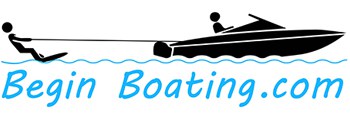Boats have different types of drive systems, depending on the intended use of the boat. Knowing this helps in your quest for having the right boat for your needs.
There are five main boat engine and drive systems. The most popular configuration is the I/O, but the reality is that each drive system has a specific advantage over the other.
- Inboard
- Outboard
- Inboard/Outboard (Stern drive)
- V-drive
- Jet drive
Let’s take a look at each boat engine and drive configuration to understand how they work, and why they’re each designed that way.
Inboard

The first boats to utilize inboard motors, were actually steam engine powered, back in the early 1800s. Inboards for our types of pleasure boats came much later. The inboard drive system is often referred to as a Direct Drive system, because the propulsion is directly inline with the engine’s crankshaft. There is very little loss of power from this design.
The Inboard drive configuration has been the standard for ski boats for about 6 decades. One of the more well known boat manufactures in the early days was Ski Nautique. Correct Craft released it’s first Ski Nautique boat in 1961. It was the first fiberglass ski boat, and was designed by Leo Bentz. It was also the world’s first tournament inboard ski boat.
Not only is Ski Nautique one of the leading ski boats still today, but they opened up this design idea for many manufactures to enter the ski boat industry. By keeping the weight of the engine centered in the boat (the engine actually sits a bit further forward than my image shows), there’s very little to no bow rise when accelerating.
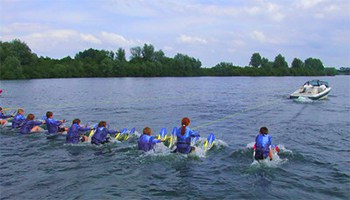 You can tow several skiers out of the water at one time and not lift the bow of your boat. The thrust is essentially all moving the boat in a forward direction from the center of the boat.
You can tow several skiers out of the water at one time and not lift the bow of your boat. The thrust is essentially all moving the boat in a forward direction from the center of the boat.
Rather than pushing from the rear of the boat like and I/O, outboard, or jet drive, the prop shaft transfers the trust up towards the center of the boat. Another advantage of having the weight centered is the nimble handling and stability of the boat.
With the propeller tucked up under the boat, there’s very little risk when towing a wakesurfer or any other towable in close proximity to the back of the boat. As guests enter and exit the boat while in the water, it’s highly unlikely that get hurt on the prop. However, by design, most direct drive boats are more for water skiing because they can produce very little wake behind your boat.
A couple disadvantages of this drive system is:
- You can’t raise up your prop when you get into a shallow water situation. The prop and shaft are in a fixed position.
- Not a terrible disadvantage, but trailering is more difficult for this same reason. You need a trailer that will not interfere with the drive.
- A big disadvantage is that the engine and it’s cover take up a lot of room, right in the middle of your boat. It’s great for a ski boat but not so much for family and friends leisure boating.
Outboard

The outboard motor drive system is very widely used and has some great advantages when used for the right purpose. It’s mounted directly onto the boat’s transom and only takes up space on the exterior of the boat. Some of the pro’s to owning an outboard powered boat are:
- Easy access to doing repairs or maintenance.
- Relatively easy to remove from the boat for storage, repair, or replacement.
- It doesn’t take up any of the boat’s interior space.
- Can be trimmed up and out of the water for shallow water conditions.
- Easily winterized for cold weather storage.
- It’s a compact “all – in – one” boat drive system.
- Creates fewer holes through the hull.
In comparison to other boat drive systems, having the ability to have full unobstructed access to the entire engine, is a huge advantage. Not only that, but you have the ability to remove the entire drive system off the boat and bring it into the shop, either for repair or climate controlled storage.
When you consider how much floor space is lost to other boat drive systems, an outboard looks pretty attractive. The fact is, that if you had a 20 foot boat with a different drive system, an 18 foot boat with an outboard would feel very similar in size from the standpoint of usable floor space.
Outboards tend to release the water used for cooling much easier than and inboard. Many people winterize their outboards without ever running any antifreeze through them. In most cases this is fine if they’re well drained. In my opinion though, antifreeze is very cheap and it would be easy to just cycle a gallon or two through. This way, if there is any residual water left, it won’t freeze.
Outboard motors are available primarily in 2-stroke and 4-stroke models. Historically the 2-stroke delivered more power per weight ratio, but as technology advances, the 4-stokes continue to get lighter and gain ground from the perspective of power to weight ratio.
Also available, is a diesel version of the outboard. They are really geared to the commercial side of boating, but they do offer a higher level of torque and better fuel economy.
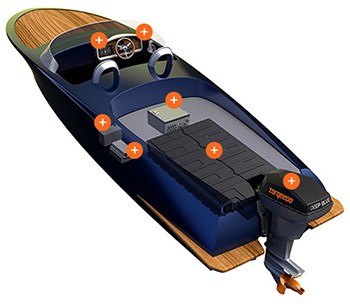 There are now electric powered versions of the outboard. A company called Torqeedo that produces outboards from 1 to 80 horsepower. While very expensive and not much history for reliability, this could be a real contender in the future. You can see in this image, that there are several components to this “green” system.
There are now electric powered versions of the outboard. A company called Torqeedo that produces outboards from 1 to 80 horsepower. While very expensive and not much history for reliability, this could be a real contender in the future. You can see in this image, that there are several components to this “green” system.
Torqeedo actually uses BMW’s i8 electric car batteries, marinized for boating, in its Deep Blue 40 and 80 horsepower propulsion systems. The 48 volt battery has an eight year capacity warranty. Big buck though, but this technology is coming!
Some disadvantages of an outboard are:
- They’re easily stolen.
- They’re easier to fix on land, but in the water it’s quite a reach to access the motor.
- Aesthetically, I think most people prefer the clean look of a boat with an inboard engine.
- Uses up valuable room for a swim deck.
- The prop is far out behind the boat for the risk of entering or exiting the boat in the water.
Inboard/Outboard (Stern Drive)

The I/O, often referred to as a Stern Drive, is the most common drive system on family style boats such as open bow, deck boats, and cuddy cruisers. The stern drive was first introduced by Volvo-Penta back in 1959. This drive system really took hold in the boating market since then.
The inboard/outboard configuration allowed for a much bigger engine, as well as having the bulk of the weight moved a bit forward into the boats hull. This also lowers the center of gravity and improves handling.
The outdrive portion resembles that of the lower portion of the outboard drive system. The outdrive can trim up very high to clear the lake bottom in shallow water conditions. When compared to the outboard drive system, the I/O does require more maintenance.
For the convenience of being able to trim up and down, a hydrolic pump and rams are added. Adding systems also adds weight and maintenance. That big outdrive also requires power steering, so that’s another added system.
 Because of having the drive system go through the boat’s transom, there are additional seals that can wear out, dry rot, or get damaged. These seals that keep the boat water tight are called “bellows”. There are generally three of them that allow for the exhaust, driveline, and shift cable to pass through the transom.
Because of having the drive system go through the boat’s transom, there are additional seals that can wear out, dry rot, or get damaged. These seals that keep the boat water tight are called “bellows”. There are generally three of them that allow for the exhaust, driveline, and shift cable to pass through the transom.
The flexibility of the bellows also allows for the outdrive to trim up and down as well as turn left and right and still remain water tight (it rhymes 🙂 ). There’s also the rubber hose for the engine’s cooling water to make it from the lake to the engine.
While the engine is a little less accessible (depending on the boats engine enclosure design), it’s still very serviceable. Also, because the engine is inside the boat, so if there was a breakdown out in the water, you can work on the engine from inside the boat.
The inboard mounted engine most often has an open cooling system. This means that water is pumped in from the body of water that you are boating in. Because of this, all inboard boats with this cooling system will need to winterize in prep for freezing temps. It’s as simple as allowing RV antifreeze to be pumped through the system, right from the water ports on the outdrive.
The conventional stern drive setup (almost all of them) have a rear facing propeller or sometimes a dual propeller. This has always been a good configuration until recent advancements in watersports. Now with some of the watersports activities taking place in close proximity to the rear of the boat like wake-surfing, the propellers are are too dangerous.
Now Volvo-Penta has come up with a design that alleviates this danger a bit by getting the propellers up under the boat. Look at the pictures below and notice the difference. This innovative design certainly makes a swimdeck on an I/O boat much safer to use. Also, having the “stab” behind the props, coupled with turning the outdrive, makes for a highly maneuverable boat.
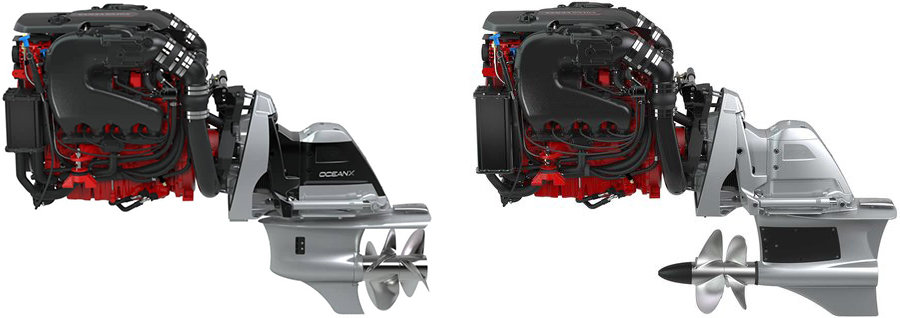
I think we’ll see more stern drives start going with similar “forward facing props” designs.
V-drive

With equal size engines, the V-drive will be a slower than a stern drive. The V-drive will also not be able to create bottom clearance in shallow water. However, the V-drive wins out in almost every other category over the stern drive (with the exception of the Volvo-Penta front facing prop outdrive).
The V-drive platform was in use at least back into the mid 1930’s. Today it’s growing in popularity for several reasons, but within family boats and sports boats in particular it’s great for:
- keeping the engine to the rear of the boat which leaves lots of open floor space
- locating the prop under the boat removing the risk of swimmers entering and exiting the boat
- weighting and creating a great wake for wakeboards and wakesurfers
- superior maneuverability
On a V-drive system the front of the engine is facing the transom. The rear of the engine is pointing forward and linked to the V-drive gear box. From the bottom of the V-drive, the prop shaft goes through the bottom of the boat, back to the prop. The rudder is directly behind the prop.
 The V-drive is used on almost every Wake Boat. There’s little to no bow rise as you launch and turning creates almost no roll in the boat. Today’s wake boats are very computerized and the driver can fill ballast in a series of bladders on board. With a touch of the screen, water flows into, or out of the designated ballasts, creating very customizable wakes for the boarders behind your boat.
The V-drive is used on almost every Wake Boat. There’s little to no bow rise as you launch and turning creates almost no roll in the boat. Today’s wake boats are very computerized and the driver can fill ballast in a series of bladders on board. With a touch of the screen, water flows into, or out of the designated ballasts, creating very customizable wakes for the boarders behind your boat.
A couple other negatives to the V-drive platform are:
- With the engine facing the transom and little space between, it’s much more difficult to service the components on the front of the engine.
- With reversing the driveshaft and all the gearing inside the V-drive transmission, there’s greater power loss when compared to direct drive systems.
- Again speed and efficiency are no match when compared to a stern drive.
- On larger boats, having the engine(‘s) all the way aft in the boat can cause the boat to take longer to plane out. (Not an issue with our size boats)
When it comes down to it, the V-drive boats are great for watersports like wakeboarding and wakesurfing. When you’re looking to buy a used boat, V-drive wakeboats are are most likely to “break the bank”. They are expensive but also hold their value.
Jet Drive

Of course the jet drive system is king for personal watercraft, but in family boating, maybe not so much. The jet drive system is fun, but it comes with it’s drawbacks. Versatility is not one of it’s strong points.
A jet drive system pumps water from the lake and forces it out, using an impeller, through a tapered nozzle at the back of the boat or PWC. The boat changes direction when the nozzle is turned left or right. For reversing your boat, a cupped gate is forced down in front of the nozzle’s exit that redirects the flow of water forward, pushing the watercraft in a backward motion.
Generally this is a problem, because in order to turn, you have to accelerate to force water out of the nozzle. I have had jet boats and personal watercrafts, and I feel that people can get used to the strange nature of operation.
Some PWC models eventually have a rudder type system added to the watercraft to allow steering without being under power. You might also attach an aftermarket rudder to your jet drive’s nozzle. A jet drive is nice for shallow water, but you do have to be careful not to suck weeds, sand, rocks, and other junk up into the impeller. The impeller’s condition is vital to the system.
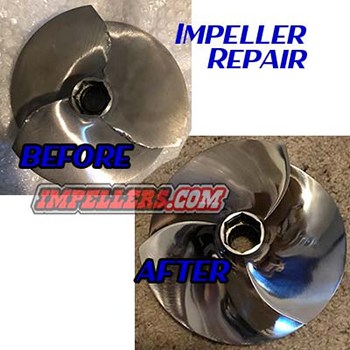 With the water being sucked up through a grate on the bottom of the watercraft, and the impeller located deep into the pump, it is almost impossible to get injured like you can on a boat’s propeller. Look at the difference between a damaged impeller and a good one.
With the water being sucked up through a grate on the bottom of the watercraft, and the impeller located deep into the pump, it is almost impossible to get injured like you can on a boat’s propeller. Look at the difference between a damaged impeller and a good one.
From the standpoint of enjoyment, I got very little out of my jet boat. My PWCs on the other hand have been a blast! From the standpoint of versatility, PWCs just might surprise you on what they are capable of.
To give an example, I bought a new Polaris Virage 700 back in 2000 or so. I use this as my example because it was a relatively low horse power watercraft at 95 hp. It was rated as a three place machine though, so I was legal to tow.
With my wife driving and my son spotting, I could slalom waterski behind it! I could through the PWC around when I cut way out to the side, so it wasn’t necessarily safe, but it was capable of doing it. We used the Polaris for a few years, until the next kid popped out. Then we went back to taking the boat. I’ve had more powerful PWCs since, but that Virage really was a great machine at the time.
As far as jet drives in family style and sport boats, they just aren’t very efficient in my opinion, given our other options, for the activities most of us enjoy when boating.
What’s The best Drive System?
There is no “best drive system”. As you’ve read, some boat drive systems have advantages over others, depending on your intended use. If I had to pick one though based on versatility, efficiency, safety, and performance for a wide range of activities, it would have to be the Volvo-Penta Forward Drive system.
There are a few other types of boat drive systems, bu they just aren’t relative to the types of boats we use for family and sport boats. For instance there is a drive system called the Pod Drive. It is used on larger ships. The drive hangs straight down below the ship and can rotate 360 degrees for propulsion in any direction. This makes docking a ship much easier.
I hope this article shed some light on the pro’s and con’s of the different boat drive systems.
